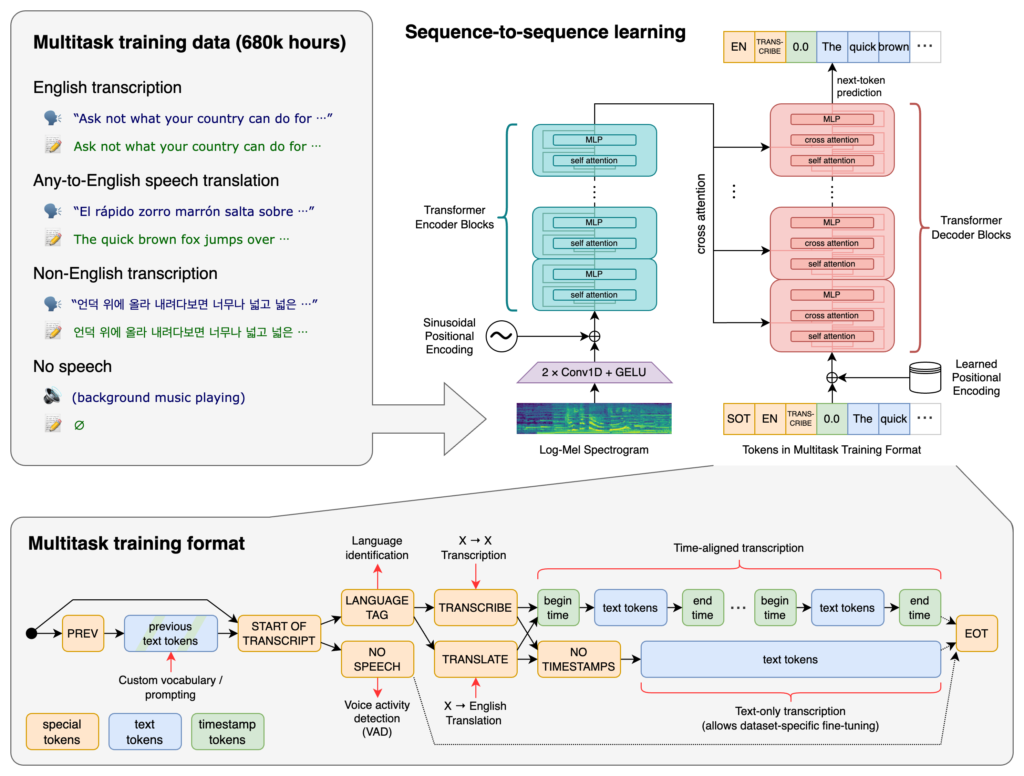
ChatGPT-5: Everything You Need to Know About OpenAI’s Breakthrough AI Model
Explore ChatGPT-5’s groundbreaking advancements, use cases, benchmarks, security, pricing, and future directions in this definitive FlowHunt guide.

OpenAI Whisper is an advanced automatic speech recognition (ASR) system that transcribes spoken language into text, supporting 99 languages, robust to accents and noise, and open-source for versatile AI applications.
OpenAI Whisper can be considered both a model and a system, depending on the context.
Whisper’s primary function is to transcribe speech into text output. It excels in:
At the heart of Whisper lies the Transformer architecture, specifically an encoder-decoder model. Transformers are neural networks that excel in processing sequential data and understanding context over long sequences. Introduced in the “Attention is All You Need” paper in 2017, Transformers have become foundational in many NLP tasks.
Whisper’s process involves:
Whisper was trained on a massive dataset of 680,000 hours of supervised data collected from the web. This includes:
With coverage of 99 languages, Whisper stands out in its ability to handle diverse linguistic inputs. This multilingual capacity makes it suitable for global applications and services targeting international audiences.
Trained on extensive supervised data, Whisper achieves high accuracy rates in transcription tasks. Its robustness to different accents, dialects, and background noises makes it reliable in various real-world scenarios.
Beyond transcription, Whisper can perform:
Released as open-source software, Whisper allows developers to:
By integrating Whisper into chatbots and AI assistants, developers can enable:
Whisper is implemented as a Python library, allowing seamless integration into Python-based projects. Using Whisper in Python involves setting up the appropriate environment, installing necessary dependencies, and utilizing the library’s functions to transcribe or translate audio files.
Before using Whisper, you need to prepare your development environment by installing Python, PyTorch, FFmpeg, and the Whisper library itself.
If you don’t have Python installed, download it from the official website . To install PyTorch, use pip:
pip install torch
Alternatively, visit the PyTorch website for specific installation instructions based on your operating system and Python version.
Whisper requires FFmpeg to process audio files. Install FFmpeg using the appropriate package manager for your operating system.
Ubuntu/Debian:
sudo apt update && sudo apt install ffmpeg
MacOS (with Homebrew):
brew install ffmpeg
Windows (with Chocolatey):
choco install ffmpeg
Install the Whisper Python package using pip:
pip install -U openai-whisper
To install the latest version directly from the GitHub repository:
pip install git+https://github.com/openai/whisper.git
Ensure that Developer Mode is enabled:
Whisper offers several models that vary in size and capabilities. The models range from tiny to large, each balancing speed and accuracy differently.
| Size | Parameters | English-only Model | Multilingual Model | Required VRAM | Relative Speed |
|---|---|---|---|---|---|
| tiny | 39 M | tiny.en | tiny | ~1 GB | ~32x |
| base | 74 M | base.en | base | ~1 GB | ~16x |
| small | 244 M | small.en | small | ~2 GB | ~6x |
| medium | 769 M | medium.en | medium | ~5 GB | ~2x |
| large | 1550 M | N/A | large | ~10 GB | 1x |
.en): Optimized for English transcription, offering improved performance for English audio.After setting up your environment and installing the necessary components, you can start using Whisper in your Python projects.
Begin by importing the Whisper library and loading a model:
import whisper
# Load the desired model
model = whisper.load_model("base")
Replace "base" with the model name that suits your application.
Whisper provides a straightforward transcribe function to convert audio files into text.
Example: Transcribing an English Audio File
# Transcribe the audio file
result = model.transcribe("path/to/english_audio.mp3")
# Print the transcription
print(result["text"])
model.transcribe(): Processes the audio file and outputs a dictionary containing the transcription and other metadata.result["text"]: Accesses the transcribed text from the result.Whisper can translate audio from various languages into English.
Example: Translating Spanish Audio to English
# Transcribe and translate Spanish audio to English
result = model.transcribe("path/to/spanish_audio.mp3", task="translate")
# Print the translated text
print(result["text"])
task="translate": Instructs the model to translate the audio into English rather than transcribe it verbatim.While Whisper can automatically detect the language, specifying it can improve accuracy and speed.
Example: Transcribing French Audio
# Transcribe French audio by specifying the language
result = model.transcribe("path/to/french_audio.wav", language="fr")
# Print the transcription
print(result["text"])
Whisper can identify the language spoken in an audio file using the detect_language method.
Example: Language Detection
# Load and preprocess the audio
audio = whisper.load_audio("path/to/unknown_language_audio.mp3")
audio = whisper.pad_or_trim(audio)
# Convert to log-Mel spectrogram
mel = whisper.log_mel_spectrogram(audio).to(model.device)
# Detect language
_, probs = model.detect_language(mel)
language = max(probs, key=probs.get)
print(f"Detected language: {language}")
whisper.load_audio(): Loads the audio file.whisper.pad_or_trim(): Adjusts the audio length to fit the model’s input requirements.whisper.log_mel_spectrogram(): Converts audio to the format expected by the model.model.detect_language(): Returns probabilities for each language, identifying the most likely language spoken.For more control over the transcription process, you can use lower-level functions and customize decoding options.
decode FunctionThe decode function allows you to specify options such as language, task, and whether to include timestamps.
Example: Custom Decoding Options
# Set decoding options
options = whisper.DecodingOptions(language="de", without_timestamps=True)
# Decode the audio
result = whisper.decode(model, mel, options)
# Print the recognized text
print(result.text)
You can integrate Whisper to transcribe live audio input from a microphone.
Example: Transcribing Live Microphone Input
import whisper
import sounddevice as sd
# Load the model
model = whisper.load_model("base")
# Record audio from the microphone
duration = 5 # seconds
fs = 16000 # Sampling rate
print("Recording...")
audio = sd.rec(int(duration * fs), samplerate=fs, channels=1, dtype='float32')
sd.wait
OpenAI Whisper is an advanced automatic speech recognition (ASR) system developed by OpenAI, designed to transcribe spoken language into written text using deep learning. It supports 99 languages and excels in transcription, translation, and language identification.
Whisper uses a transformer-based encoder-decoder architecture, processes audio into log-Mel spectrograms, and outputs text via a language model. It was trained on 680,000 hours of multilingual, multitask data for high accuracy and robustness.
Whisper supports multilingual speech recognition, speech translation, automatic language identification, robustness to accents and noise, and provides open-source access for customization and integration.
Hardware requirements depend on the model size: smaller models like 'tiny' require ~1GB VRAM, while the largest requires ~10GB. Whisper runs faster on GPUs but can work on CPUs with longer processing times.
Yes, Whisper is implemented as a Python library and can be installed via pip. It allows for easy integration into Python projects for speech transcription, translation, and real-time voice applications.
Common use cases include automated meeting transcription, voice-enabled chatbots, live translation, accessibility tools (captions and assistive tech), call center automation, and voice-controlled automation systems.
Yes, alternatives include open-source engines like Mozilla DeepSpeech, Kaldi, Wav2vec, and commercial APIs such as Google Cloud Speech-to-Text, Microsoft Azure AI Speech, and AWS Transcribe.
Yes, OpenAI Whisper is open-source, allowing developers to customize, fine-tune, and integrate it into their own products and services without licensing constraints.
Integrate advanced speech-to-text capabilities into your applications, automate workflows, and enhance user experience with OpenAI Whisper and FlowHunt.

Explore ChatGPT-5’s groundbreaking advancements, use cases, benchmarks, security, pricing, and future directions in this definitive FlowHunt guide.

Learn how to build an AI chatbot from scratch with our comprehensive guide. Discover the best tools, frameworks, and step-by-step process to create intelligent ...

Learn what AI chatbot GPT is, how it works, and why ChatGPT is the leading generative AI solution. Discover transformer architecture, training methods, and real...
Cookie Consent
We use cookies to enhance your browsing experience and analyze our traffic. See our privacy policy.